rear spring YAMAHA WR 250F 2007 Owners Manual
[x] Cancel search | Manufacturer: YAMAHA, Model Year: 2007, Model line: WR 250F, Model: YAMAHA WR 250F 2007Pages: 912, PDF Size: 23.95 MB
Page 22 of 912
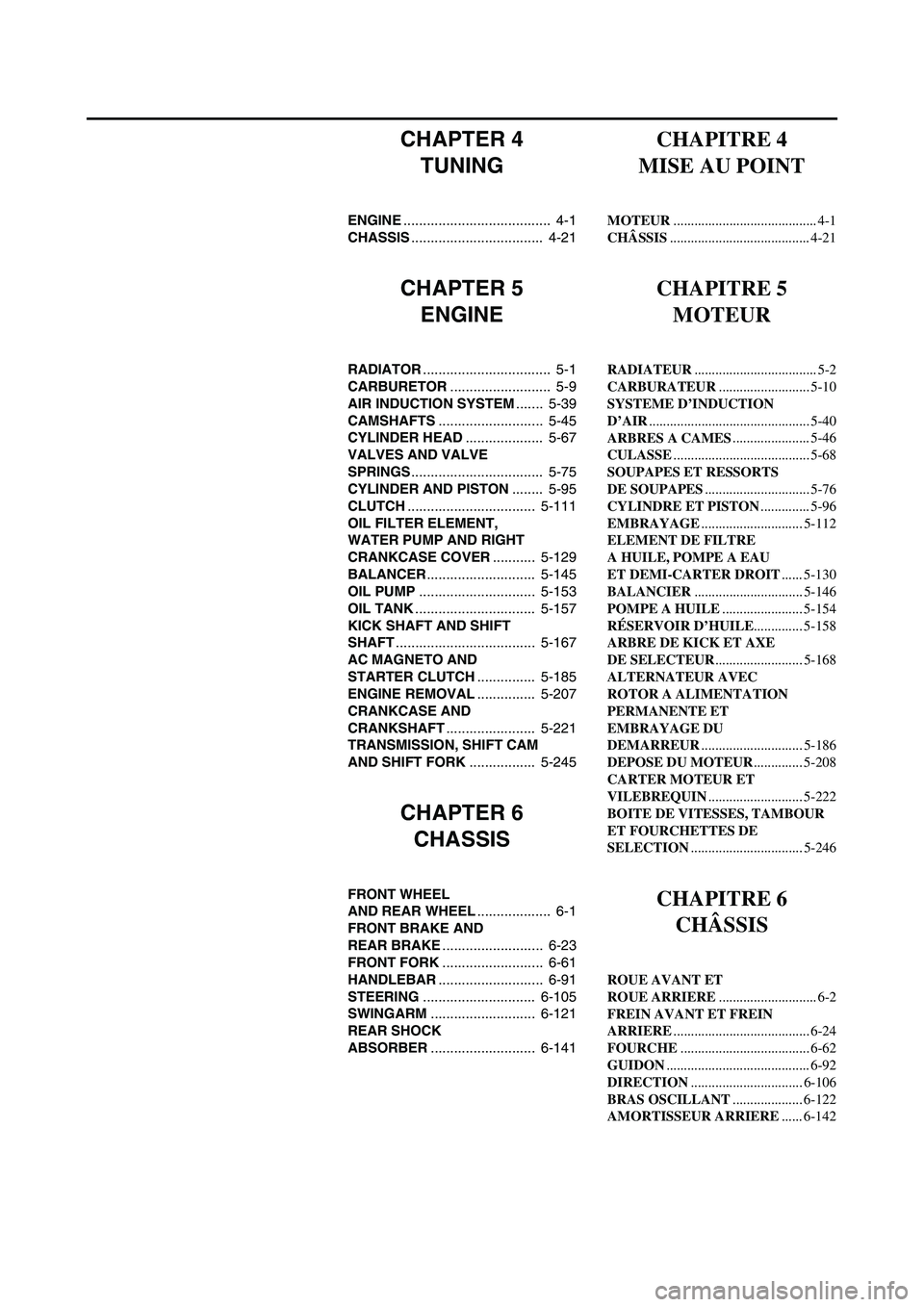
CHAPTER 4
TUNING
ENGINE...................................... 4-1
CHASSIS.................................. 4-21
CHAPTER 5
ENGINE
RADIATOR................................. 5-1
CARBURETOR.......................... 5-9
AIR INDUCTION SYSTEM....... 5-39
CAMSHAFTS........................... 5-45
CYLINDER HEAD.................... 5-67
VALVES AND VALVE
SPRINGS.................................. 5-75
CYLINDER AND PISTON........ 5-95
CLUTCH................................. 5-111
OIL FILTER ELEMENT,
WATER PUMP AND RIGHT
CRANKCASE COVER........... 5-129
BALANCER............................ 5-145
OIL PUMP.............................. 5-153
OIL TANK............................... 5-157
KICK SHAFT AND SHIFT
SHAFT.................................... 5-167
AC MAGNETO AND
STARTER CLUTCH............... 5-185
ENGINE REMOVAL............... 5-207
CRANKCASE AND
CRANKSHAFT....................... 5-221
TRANSMISSION, SHIFT CAM
AND SHIFT FORK................. 5-245
CHAPTER 6
CHASSIS
FRONT WHEEL
AND REAR WHEEL................... 6-1
FRONT BRAKE AND
REAR BRAKE.......................... 6-23
FRONT FORK.......................... 6-61
HANDLEBAR........................... 6-91
STEERING............................. 6-105
SWINGARM........................... 6-121
REAR SHOCK
ABSORBER........................... 6-141
CHAPITRE 4
MISE AU POINT
MOTEUR......................................... 4-1
CHÂSSIS........................................ 4-21
CHAPITRE 5
MOTEUR
RADIATEUR................................... 5-2
CARBURATEUR.......................... 5-10
SYSTEME D’INDUCTION
D’AIR.............................................. 5-40
ARBRES A CAMES...................... 5-46
CULASSE....................................... 5-68
SOUPAPES ET RESSORTS
DE SOUPAPES.............................. 5-76
CYLINDRE ET PISTON.............. 5-96
EMBRAYAGE............................. 5-112
ELEMENT DE FILTRE
A HUILE, POMPE A EAU
ET DEMI-CARTER DROIT...... 5-130
BALANCIER............................... 5-146
POMPE A HUILE....................... 5-154
RÉSERVOIR D’HUILE.............. 5-158
ARBRE DE KICK ET AXE
DE SELECTEUR......................... 5-168
ALTERNATEUR AVEC
ROTOR A ALIMENTATION
PERMANENTE ET
EMBRAYAGE DU
DEMARREUR............................. 5-186
DEPOSE DU MOTEUR.............. 5-208
CARTER MOTEUR ET
VILEBREQUIN........................... 5-222
BOITE DE VITESSES, TAMBOUR
ET FOURCHETTES DE
SELECTION................................ 5-246
CHAPITRE 6
CHÂSSIS
ROUE AVANT ET
ROUE ARRIERE............................ 6-2
FREIN AVANT ET FREIN
ARRIERE....................................... 6-24
FOURCHE..................................... 6-62
GUIDON......................................... 6-92
DIRECTION................................ 6-106
BRAS OSCILLANT.................... 6-122
AMORTISSEUR ARRIERE...... 6-142
Page 96 of 912

GENERAL SPECIFICATIONS
2 - 3
SPEC
Brake:
Front brake type Single disc brake
Operation Right hand operation
Rear brake type Single disc brake
Operation Right foot operation
Suspension:
Front suspension Telescopic fork
Rear suspension Swingarm (link type monocross suspension)
Shock absorber:
Front shock absorber Coil spring/oil damper
Rear shock absorber Coil spring/gas, oil damper
Wheel travel:
Front wheel travel 300 mm (11.8 in)
Rear wheel travel 310 mm (12.2 in)
Electrical:
Ignition system CDI
Generator system AC magneto
Battery type YTX5L-BS
Battery voltage/capacity 12 V/4 AH
Specific gravity 1.320
Headlight type: Quartz bulb (halogen)
Bulb wattage × quantity:
Headlight 12 V 35/36.5 W × 1
Taillight 12 V 1.6/0.3 W × 1
Page 105 of 912
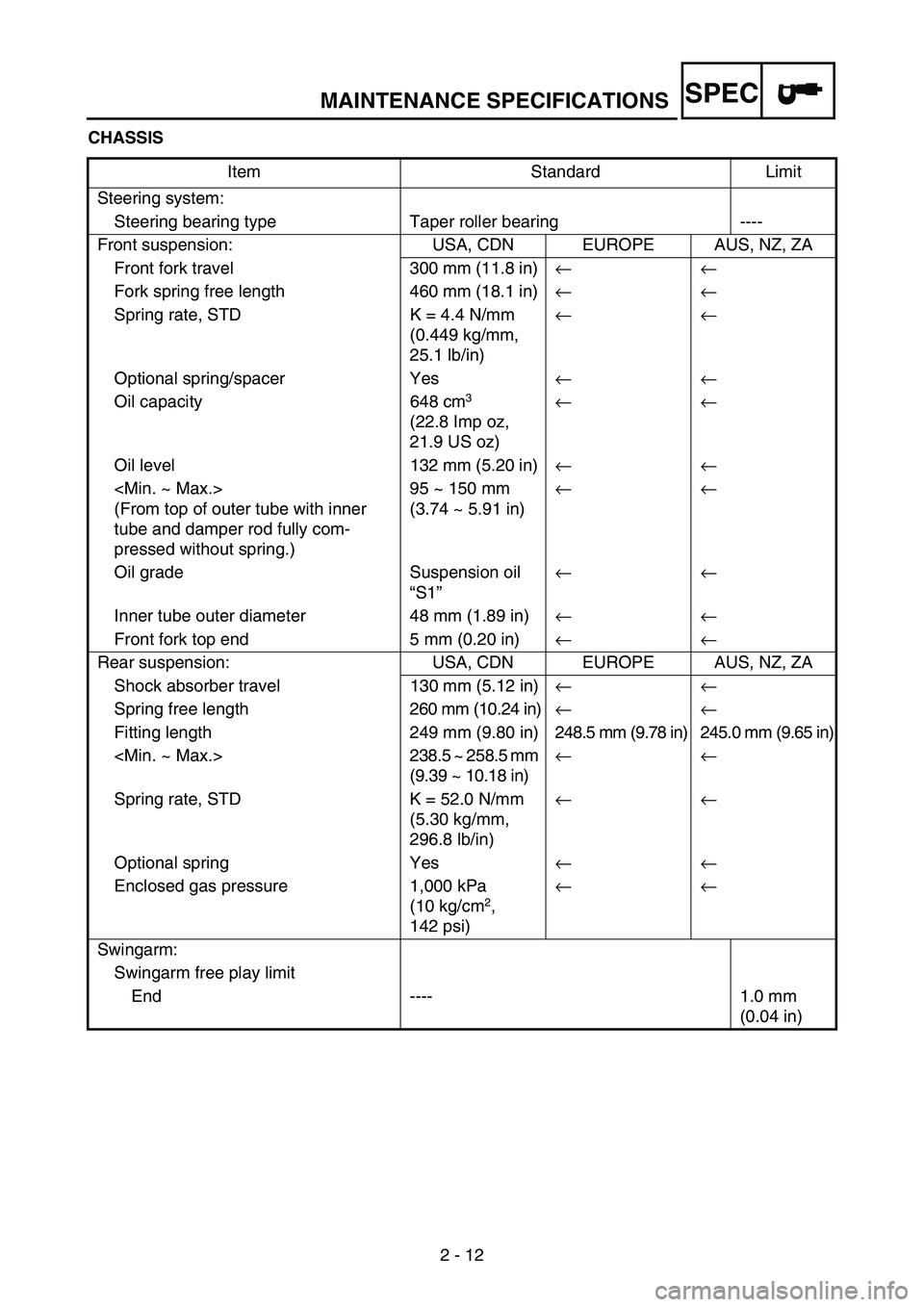
MAINTENANCE SPECIFICATIONS
2 - 12
SPEC
CHASSIS
Item Standard Limit
Steering system:
Steering bearing type Taper roller bearing ----
Front suspension: USA, CDN EUROPE AUS, NZ, ZA
Front fork travel 300 mm (11.8 in)←←
Fork spring free length 460 mm (18.1 in)←←
Spring rate, STD K = 4.4 N/mm
(0.449 kg/mm,
25.1 lb/in)←←
Optional spring/spacer Yes←←
Oil capacity 648 cm
3
(22.8 Imp oz,
21.9 US oz) ←←
Oil level 132 mm (5.20 in)←←
(From top of outer tube with inner
tube and damper rod fully com-
pressed without spring.)95 ~ 150 mm
(3.74 ~ 5.91 in)←←
Oil grade Suspension oil
“S1”←←
Inner tube outer diameter 48 mm (1.89 in)←←
Front fork top end 5 mm (0.20 in)←←
Rear suspension: USA, CDN EUROPE AUS, NZ, ZA
Shock absorber travel 130 mm (5.12 in)← ←
Spring free length260 mm (10.24 in)← ←
Fitting length 249 mm (9.80 in) 248.5 mm (9.78 in) 245.0 mm (9.65 in)
(9.39 ~ 10.18 in)← ←
Spring rate, STD K = 52.0 N/mm
(5.30 kg/mm,
296.8 lb/in)← ←
Optional spring Yes← ←
Enclosed gas pressure 1,000 kPa
(10 kg/cm
2,
142 psi)← ←
Swingarm:
Swingarm free play limit
End ---- 1.0 mm
(0.04 in)
Page 202 of 912
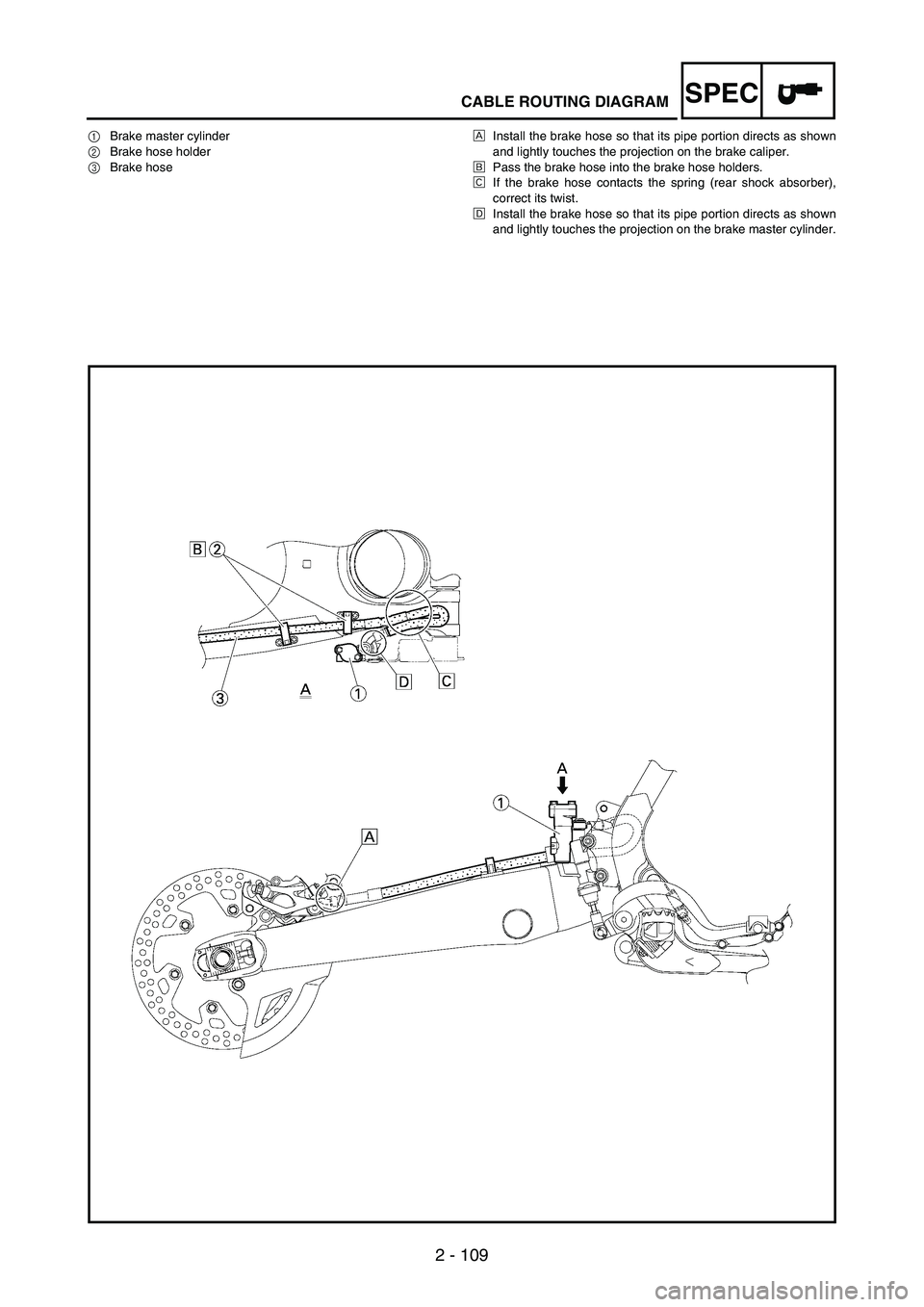
SPEC
2 - 109
CABLE ROUTING DIAGRAM
1Brake master cylinder
2Brake hose holder
3Brake hoseÈInstall the brake hose so that its pipe portion directs as shown
and lightly touches the projection on the brake caliper.
ÉPass the brake hose into the brake hose holders.
ÊIf the brake hose contacts the spring (rear shock absorber),
correct its twist.
ËInstall the brake hose so that its pipe portion directs as shown
and lightly touches the projection on the brake master cylinder.
Page 314 of 912
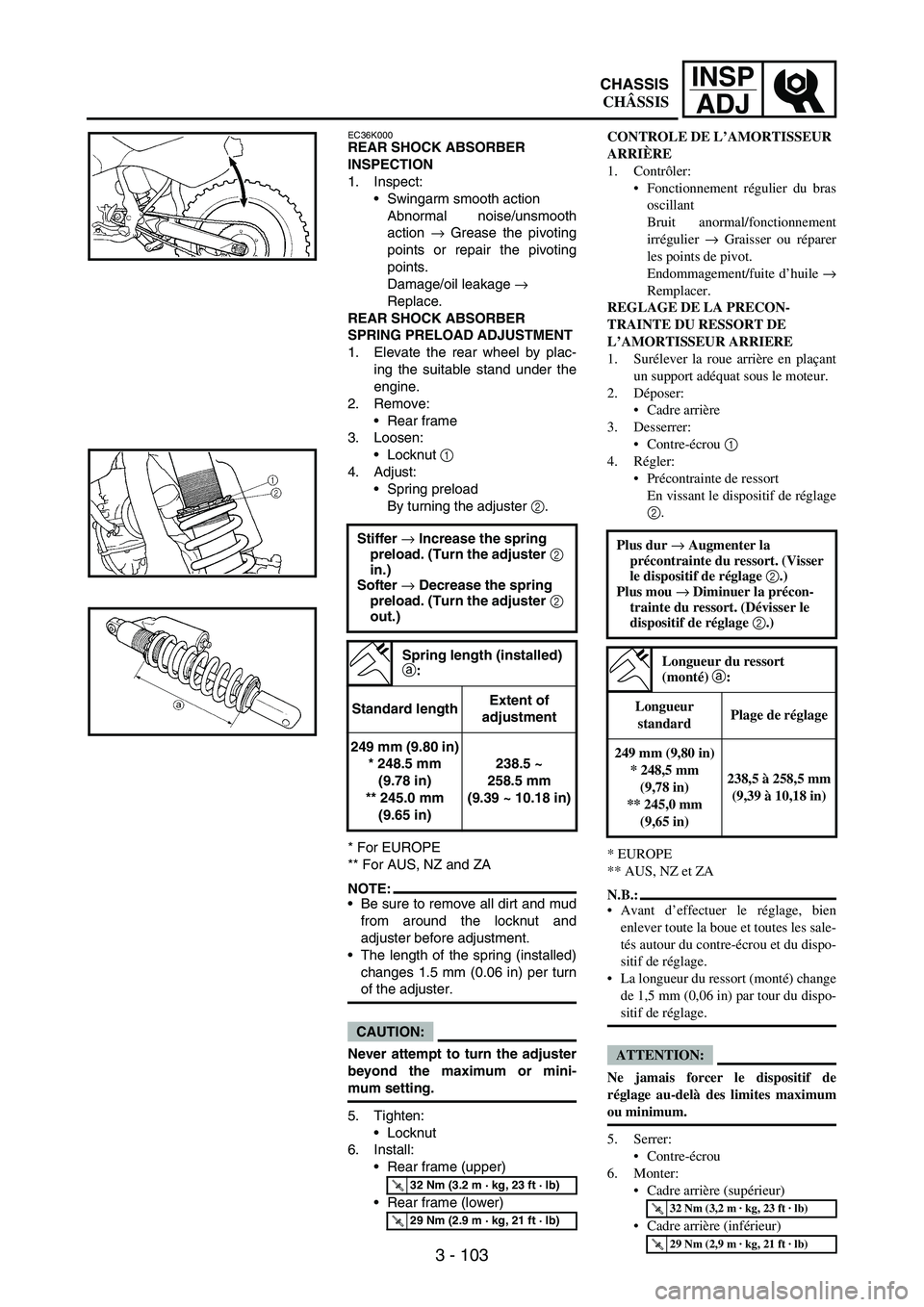
3 - 103
INSP
ADJ
EC36K000REAR SHOCK ABSORBER
INSPECTION
1. Inspect:
Swingarm smooth action
Abnormal noise/unsmooth
action
→ Grease the pivoting
points or repair the pivoting
points.
Damage/oil leakage
→
Replace.
REAR SHOCK ABSORBER
SPRING PRELOAD ADJUSTMENT
1. Elevate the rear wheel by plac-
ing the suitable stand under the
engine.
2. Remove:
Rear frame
3. Loosen:
Locknut
1
4. Adjust:
Spring preload
By turning the adjuster
2.
* For EUROPE
** For AUS, NZ and ZA
NOTE:Be sure to remove all dirt and mud
from around the locknut and
adjuster before adjustment.
The length of the spring (installed)
changes 1.5 mm (0.06 in) per turn
of the adjuster.
CAUTION:
Never attempt to turn the adjuster
beyond the maximum or mini-
mum setting.
5. Tighten:
Locknut
6. Install:
Rear frame (upper)
Rear frame (lower) Stiffer → Increase the spring
preload. (Turn the adjuster 2
in.)
Softer → Decrease the spring
preload. (Turn the adjuster 2
out.)
Spring length (installed)
a:
Standard lengthExtent of
adjustment
249 mm (9.80 in)
* 248.5 mm
(9.78 in)
** 245.0 mm
(9.65 in)238.5 ~
258.5 mm
(9.39 ~ 10.18 in)
T R..32 Nm (3.2 m · kg, 23 ft · lb)
T R..29 Nm (2.9 m · kg, 21 ft · lb)
CONTROLE DE L’AMORTISSEUR
ARRIÈRE
1. Contrôler:
Fonctionnement régulier du bras
oscillant
Bruit anormal/fonctionnement
irrégulier → Graisser ou réparer
les points de pivot.
Endommagement/fuite d’huile →
Remplacer.
REGLAGE DE LA PRECON-
TRAINTE DU RESSORT DE
L’AMORTISSEUR ARRIERE
1. Surélever la roue arrière en plaçant
un support adéquat sous le moteur.
2. Déposer:
Cadre arrière
3. Desserrer:
Contre-écrou 1
4. Régler:
Précontrainte de ressort
En vissant le dispositif de réglage
2.
* EUROPE
** AUS, NZ et ZA
N.B.:
Avant d’effectuer le réglage, bien
enlever toute la boue et toutes les sale-
tés autour du contre-écrou et du dispo-
sitif de réglage.
La longueur du ressort (monté) change
de 1,5 mm (0,06 in) par tour du dispo-
sitif de réglage.
ATTENTION:
Ne jamais forcer le dispositif de
réglage au-delà des limites maximum
ou minimum.
5. Serrer:
Contre-écrou
6. Monter:
Cadre arrière (supérieur)
Cadre arrière (inférieur) Plus dur → Augmenter la
précontrainte du ressort. (Visser
le dispositif de réglage 2.)
Plus mou → Diminuer la précon-
trainte du ressort. (Dévisser le
dispositif de réglage 2.)
Longueur du ressort
(monté) a:
Longueur
standardPlage de réglage
249 mm (9,80 in)
* 248,5 mm
(9,78 in)
** 245,0 mm
(9,65 in)238,5 à 258,5 mm
(9,39 à 10,18 in)
T R..32 Nm (3,2 m · kg, 23 ft · lb)
T R..29 Nm (2,9 m · kg, 21 ft · lb)
CHASSIS
CHÂSSIS
Page 388 of 912

4 - 29
TUNSETTING
EC72A001Setting of spring after
replacement
As the front fork setting can be easily
affected by rear suspension, take
care so that the machine front and
rear are balanced (in position, etc.)
when setting the front fork.
1. Use of soft spring
Generally a soft spring gives a
soft riding feeling. Rebound
damping tends to become stron-
ger and the front fork may sink
deeply over a series of gaps.
To set a soft spring:
Change the rebound damping.
Turn out one or two clicks.
Change the compression
damping.
Turn in one or two clicks.
2. Use of stiff spring
Generally a stiff spring gives a
stiff riding feeling. Rebound
damping tends to become
weaker, resulting in lack of a
sense of contact with the road
surface or in a vibrating handle-
bar.
To set a stiff spring:
Change the rebound damping.
Turn in one or two clicks.
Change the compression
damping.
Turn out one or two clicks.Réglage du ressort après
remplacement
La suspension arrière pouvant influencer
le réglage de la fourche, il convient donc
d’équilibrer l’arrière et l’avant de la
machine (la position, etc.) avant d’effec-
tuer le réglage de la fourche.
1. Ressort mou
En général, un ressort mou offre une
sensation de conduite douce. La
force de rebond tend à être plus
forte et la fourche peut s’enfoncer
plus profondément lors de la con-
duite sur des routes cahoteuses.
Réglage d’un ressort mou:
Régler la force d’amortissement à
la détente.
Dévisser d’un ou deux déclics.
Régler la force de compression.
Visser d’un ou deux déclics.
2. Ressort dur
En principe, un ressort dur offre une
sensation de conduite dure. L’amor-
tissement à la détente a tendance à
s’affaiblir, entraînant une perte de la
sensation de contact avec la surface
de la route ou des vibrations du gui-
don.
Réglage d’un ressort dur:
Régler la force d’amortissement à
la détente.
Visser d’un ou deux déclics.
Régler la force de compression.
Dévisser d’un ou deux déclics.
REGLAGE
Page 392 of 912
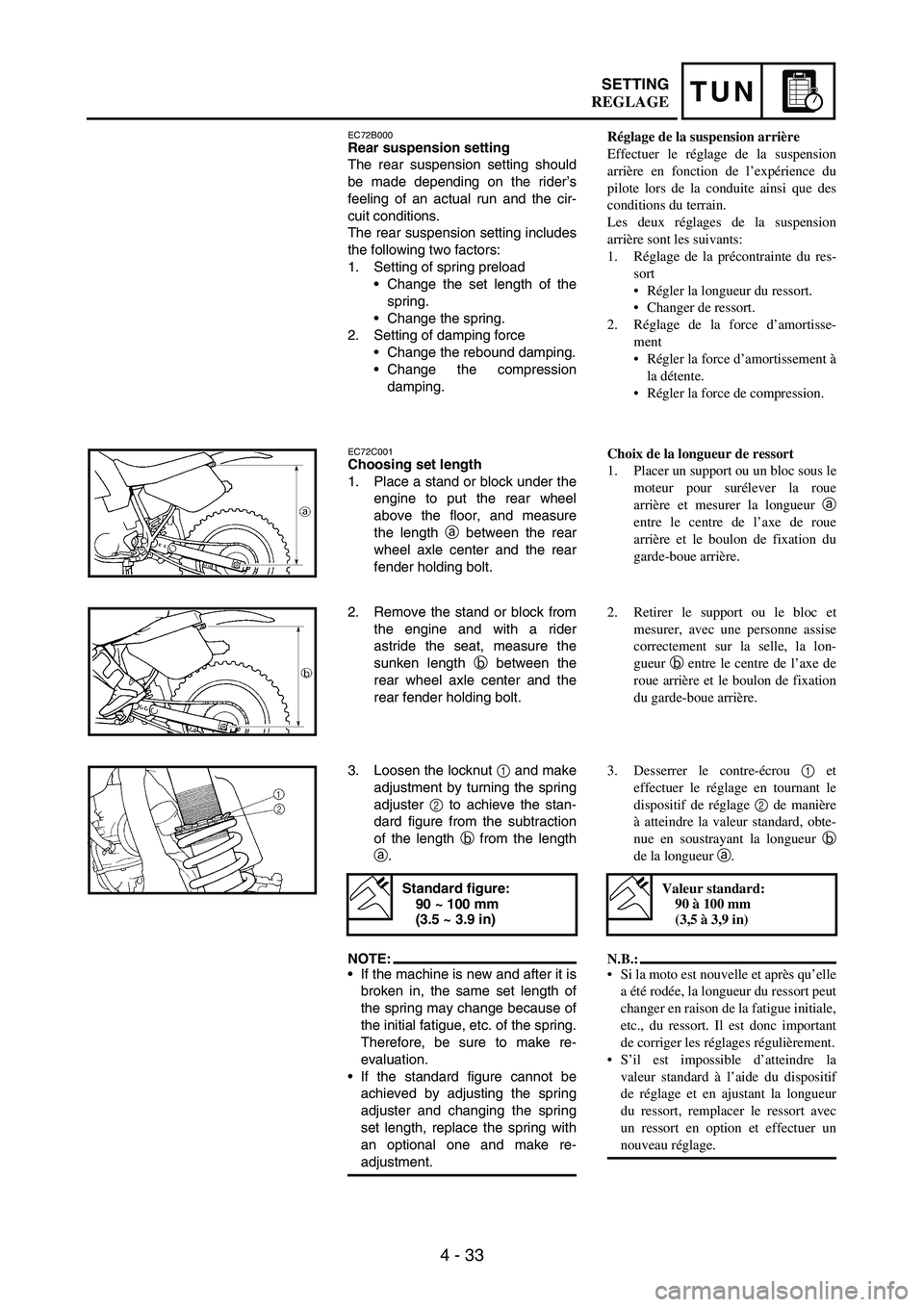
4 - 33
TUNSETTING
EC72B000Rear suspension setting
The rear suspension setting should
be made depending on the rider’s
feeling of an actual run and the cir-
cuit conditions.
The rear suspension setting includes
the following two factors:
1. Setting of spring preload
Change the set length of the
spring.
Change the spring.
2. Setting of damping force
Change the rebound damping.
Change the compression
damping.
EC72C001Choosing set length
1. Place a stand or block under the
engine to put the rear wheel
above the floor, and measure
the length
a between the rear
wheel axle center and the rear
fender holding bolt.
2. Remove the stand or block from
the engine and with a rider
astride the seat, measure the
sunken length
b between the
rear wheel axle center and the
rear fender holding bolt.
3. Loosen the locknut
1 and make
adjustment by turning the spring
adjuster
2 to achieve the stan-
dard figure from the subtraction
of the length
b from the length
a.
NOTE:If the machine is new and after it is
broken in, the same set length of
the spring may change because of
the initial fatigue, etc. of the spring.
Therefore, be sure to make re-
evaluation.
If the standard figure cannot be
achieved by adjusting the spring
adjuster and changing the spring
set length, replace the spring with
an optional one and make re-
adjustment.
Standard figure:
90 ~ 100 mm
(3.5 ~ 3.9 in)
Réglage de la suspension arrière
Effectuer le réglage de la suspension
arrière en fonction de l’expérience du
pilote lors de la conduite ainsi que des
conditions du terrain.
Les deux réglages de la suspension
arrière sont les suivants:
1. Réglage de la précontrainte du res-
sort
Régler la longueur du ressort.
Changer de ressort.
2. Réglage de la force d’amortisse-
ment
Régler la force d’amortissement à
la détente.
Régler la force de compression.
Choix de la longueur de ressort
1. Placer un support ou un bloc sous le
moteur pour surélever la roue
arrière et mesurer la longueur a
entre le centre de l’axe de roue
arrière et le boulon de fixation du
garde-boue arrière.
2. Retirer le support ou le bloc et
mesurer, avec une personne assise
correctement sur la selle, la lon-
gueur b entre le centre de l’axe de
roue arrière et le boulon de fixation
du garde-boue arrière.
3. Desserrer le contre-écrou 1 et
effectuer le réglage en tournant le
dispositif de réglage 2 de manière
à atteindre la valeur standard, obte-
nue en soustrayant la longueur b
de la longueur a.
N.B.:
Si la moto est nouvelle et après qu’elle
a été rodée, la longueur du ressort peut
changer en raison de la fatigue initiale,
etc., du ressort. Il est donc important
de corriger les réglages régulièrement.
S’il est impossible d’atteindre la
valeur standard à l’aide du dispositif
de réglage et en ajustant la longueur
du ressort, remplacer le ressort avec
un ressort en option et effectuer un
nouveau réglage.
Valeur standard:
90 à 100 mm
(3,5 à 3,9 in)
REGLAGE
Page 394 of 912
![YAMAHA WR 250F 2007 Owners Manual 4 - 35
TUNSETTING
Setting of spring after
replacement
After replacement, be sure to adjust
the spring to the set length [sunken
length 90 ~ 100 mm (3.5 ~ 3.9 in)]
and set it.
1. Use of soft spring
S YAMAHA WR 250F 2007 Owners Manual 4 - 35
TUNSETTING
Setting of spring after
replacement
After replacement, be sure to adjust
the spring to the set length [sunken
length 90 ~ 100 mm (3.5 ~ 3.9 in)]
and set it.
1. Use of soft spring
S](/img/51/52333/w960_52333-393.png)
4 - 35
TUNSETTING
Setting of spring after
replacement
After replacement, be sure to adjust
the spring to the set length [sunken
length 90 ~ 100 mm (3.5 ~ 3.9 in)]
and set it.
1. Use of soft spring
Set the soft spring for less
rebound damping to compen-
sate for its less spring load.
Run with the rebound damping
adjuster one or two clicks on
the softer side and readjust it
to suit your preference.
2. Use of stiff spring
Set the soft spring for more
rebound damping to compen-
sate for its greater spring load.
Run with the rebound damping
adjuster one or two clicks on
the stiffer side and readjust it
to suit your preference.
*Adjusting the rebound damp-
ing will be followed more or
less by a change in the com-
pression damping. For correc-
tion, turn the low compression
damping adjuster on the softer
side.
CAUTION:
When using a rear shock absorber
other than currently installed, use
the one whose overall length a
does not exceed the standard as it
may result in faulty performance.
Never use one whose overall
length is greater than standard.
Length a
of standard
shock:
488.5 mm (19.23 in)
Réglage du ressort après
remplacement
Après avoir remplacé le ressort, veiller à
l’ajuster à la longueur recommandée
[profondeur 90 à 100 mm (3,5 à 3,9 in)]
et à le régler.
1. Ressort mou
Régler le ressort mou de manière
que la force d’amortissement à la
détente soit moindre afin de com-
penser son manque de raideur.
Après avoir, à l’aide du dispositif
de réglage, diminué la force
d’amortissement à la détente d’un
ou deux déclics, rouler avec la
moto puis effectuer un nouveau
réglage en fonction des préféren-
ces personnelles.
2. Ressort dur
Régler le ressort de manière à
augmenter la force d’amortisse-
ment à la détente afin de compen-
ser la plus grande raideur du
ressort. Après avoir, à l’aide du
dispositif de réglage, augmenté la
force d’amortissement à la
détente d’un ou deux déclics, rou-
ler avec la moto puis effectuer un
nouveau réglage en fonction des
préférences personnelles.
*Un réglage de la force d’amortis-
sement à la détente entraîne un
changement de la force de com-
pression. Pour corriger, dévisser
le dispositif de réglage de la force
de compression.
ATTENTION:
Lors du remplacement de l’amortis-
seur arrière, veiller à monter un
amortisseur dont la longueur totale a
ne dépasse pas la longueur standard
sous peine d’altérer les performances.
Ne jamais monter un amortisseur
dont la longueur totale est supérieure
à la longueur standard.
Longueur a de
l’amortisseur standard:
488,5 mm (19,23 in)
REGLAGE
Page 396 of 912
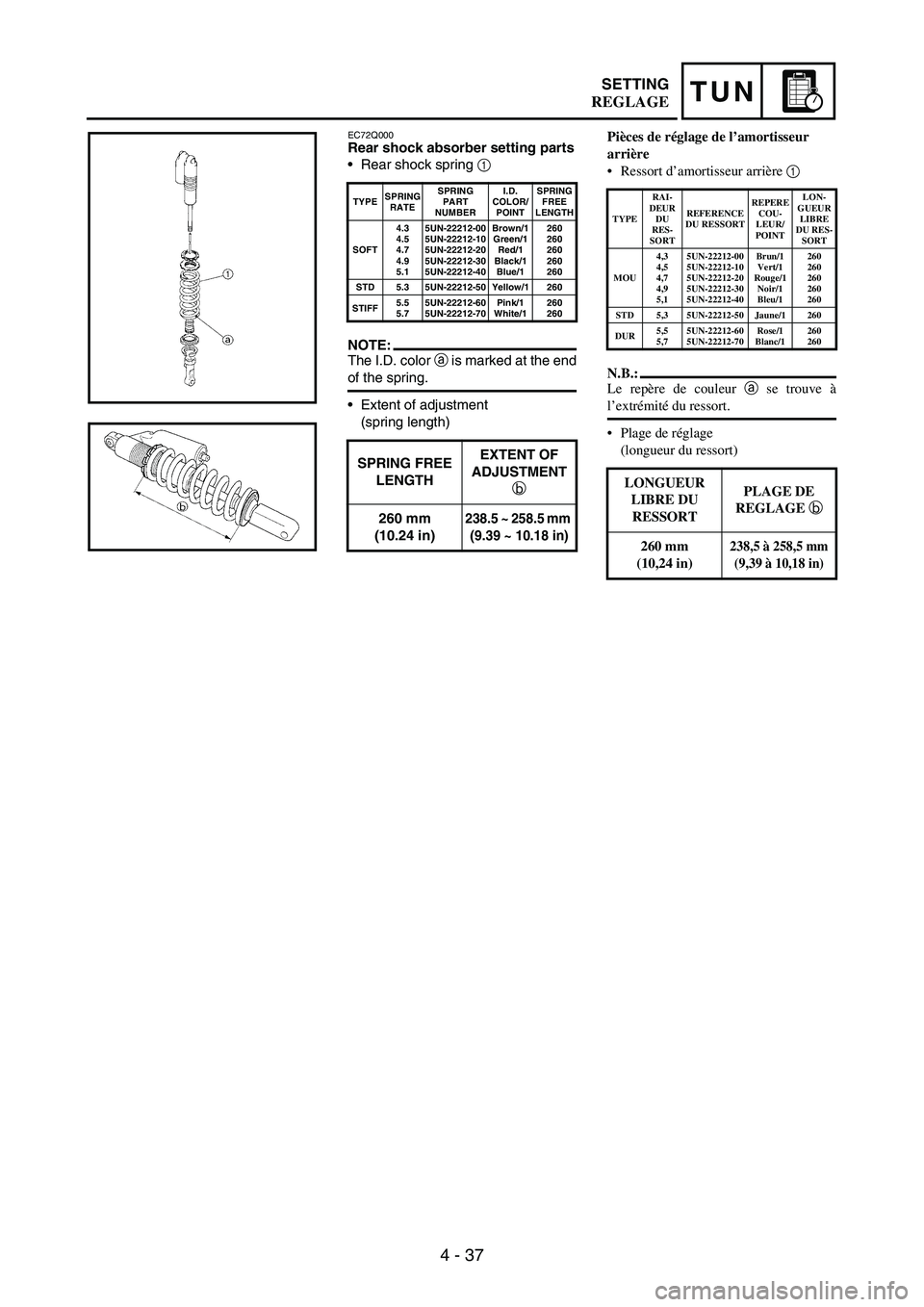
4 - 37
TUNSETTING
EC72Q000Rear shock absorber setting parts
Rear shock spring
1
NOTE:The I.D. color
a is marked at the end
of the spring.
Extent of adjustment
(spring length)
TYPESPRING
RATESPRING
PART
NUMBERI.D.
COLOR/
POINTSPRING
FREE
LENGTH
SOFT4.3
4.5
4.7
4.9
5.15UN-22212-00
5UN-22212-10
5UN-22212-20
5UN-22212-30
5UN-22212-40Brown/1
Green/1
Red/1
Black/1
Blue/1260
260
260
260
260
STD 5.3 5UN-22212-50 Yellow/1 260
STIFF5.5
5.75UN-22212-60
5UN-22212-70Pink/1
White/1260
260
SPRING FREE
LENGTHEXTENT OF
ADJUSTMENT
b
260 mm
(10.24 in)
238.5 ~ 258.5 mm
(9.39 ~ 10.18 in)
Pièces de réglage de l’amortisseur
arrière
Ressort d’amortisseur arrière 1
N.B.:
Le repère de couleur a se trouve à
l’extrémité du ressort.
Plage de réglage
(longueur du ressort)
TYPERAI-
DEUR
DU
RES-
SORTREFERENCE
DU RESSORTREPERE
COU-
LEUR/
POINTLON-
GUEUR
LIBRE
DU RES-
SORT
MOU4,3
4,5
4,7
4,9
5,15UN-22212-00
5UN-22212-10
5UN-22212-20
5UN-22212-30
5UN-22212-40Brun/1
Vert/1
Rouge/1
Noir/1
Bleu/1260
260
260
260
260
STD 5,3 5UN-22212-50 Jaune/1 260
DUR5,5
5,75UN-22212-60
5UN-22212-70Rose/1
Blanc/1260
260
LONGUEUR
LIBRE DU
RESSORT PLAGE DE
REGLAGE b
260 mm
(10,24 in)
238,5 à 258,5 mm
(9,39 à 10,18 in)
REGLAGE
Page 398 of 912
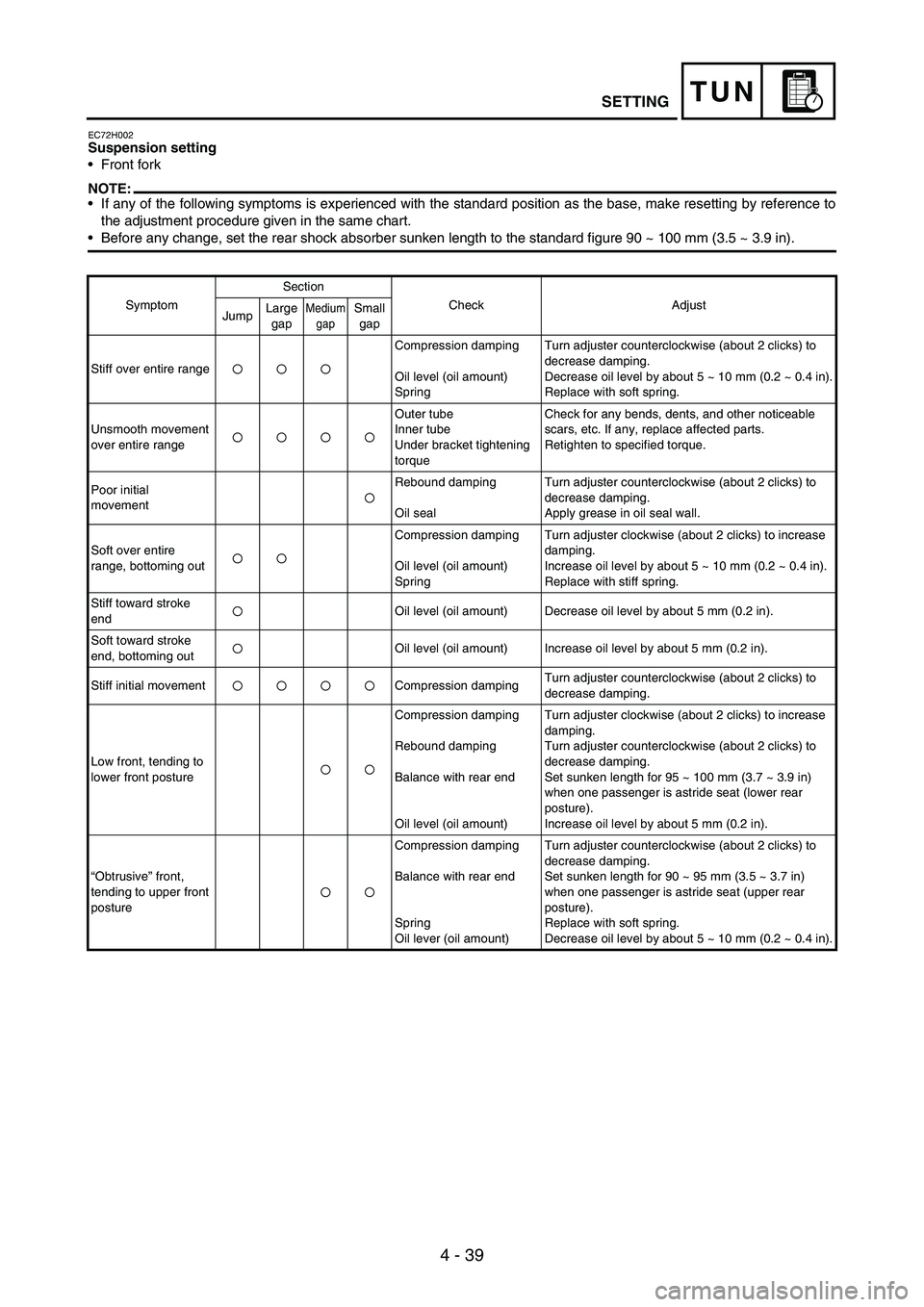
4 - 39
TUNSETTING
EC72H002Suspension setting
Front fork
NOTE:If any of the following symptoms is experienced with the standard position as the base, make resetting by reference to
the adjustment procedure given in the same chart.
Before any change, set the rear shock absorber sunken length to the standard figure 90 ~ 100 mm (3.5 ~ 3.9 in).
SymptomSection
Check Adjust
JumpLarge
gapMedium
gapSmall
gap
Stiff over entire rangeCompression damping
Oil level (oil amount)
SpringTurn adjuster counterclockwise (about 2 clicks) to
decrease damping.
Decrease oil level by about 5 ~ 10 mm (0.2 ~ 0.4 in).
Replace with soft spring.
Unsmooth movement
over entire rangeOuter tube
Inner tube
Under bracket tightening
torqueCheck for any bends, dents, and other noticeable
scars, etc. If any, replace affected parts.
Retighten to specified torque.
Poor initial
movementRebound damping
Oil sealTurn adjuster counterclockwise (about 2 clicks) to
decrease damping.
Apply grease in oil seal wall.
Soft over entire
range, bottoming outCompression damping
Oil level (oil amount)
SpringTurn adjuster clockwise (about 2 clicks) to increase
damping.
Increase oil level by about 5 ~ 10 mm (0.2 ~ 0.4 in).
Replace with stiff spring.
Stiff toward stroke
endOil level (oil amount) Decrease oil level by about 5 mm (0.2 in).
Soft toward stroke
end, bottoming outOil level (oil amount) Increase oil level by about 5 mm (0.2 in).
Stiff initial movement Compression dampingTurn adjuster counterclockwise (about 2 clicks) to
decrease damping.
Low front, tending to
lower front postureCompression damping
Rebound damping
Balance with rear end
Oil level (oil amount)Turn adjuster clockwise (about 2 clicks) to increase
damping.
Turn adjuster counterclockwise (about 2 clicks) to
decrease damping.
Set sunken length for 95 ~ 100 mm (3.7 ~ 3.9 in)
when one passenger is astride seat (lower rear
posture).
Increase oil level by about 5 mm (0.2 in).
“Obtrusive” front,
tending to upper front
postureCompression damping
Balance with rear end
Spring
Oil lever (oil amount)Turn adjuster counterclockwise (about 2 clicks) to
decrease damping.
Set sunken length for 90 ~ 95 mm (3.5 ~ 3.7 in)
when one passenger is astride seat (upper rear
posture).
Replace with soft spring.
Decrease oil level by about 5 ~ 10 mm (0.2 ~ 0.4 in).